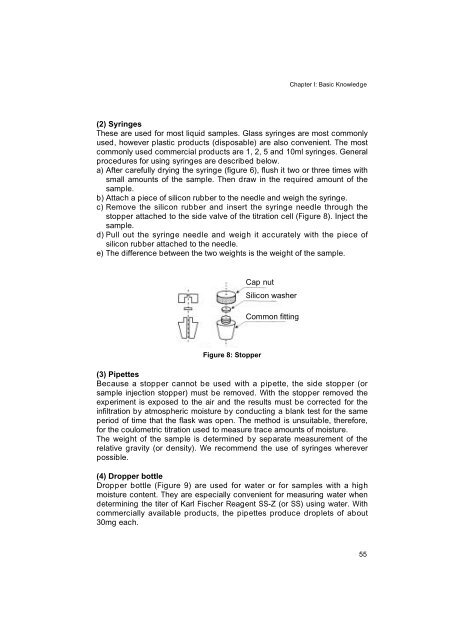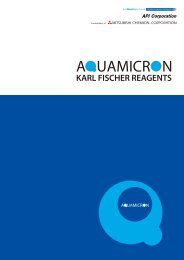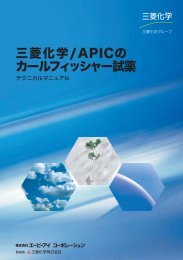Development of Karl Fischer Reagents
Development of Karl Fischer Reagents
Development of Karl Fischer Reagents
Create successful ePaper yourself
Turn your PDF publications into a flip-book with our unique Google optimized e-Paper software.
Chapter I: Basic Knowledge<br />
(2) Syringes<br />
These are used for most liquid samples. Glass syringes are most commonly<br />
used, however plastic products (disposable) are also convenient. The most<br />
commonly used commercial products are 1, 2, 5 and 10ml syringes. General<br />
procedures for using syringes are described below.<br />
a) After carefully drying the syringe (figure 6), flush it two or three times with<br />
small amounts <strong>of</strong> the sample. Then draw in the required amount <strong>of</strong> the<br />
sample.<br />
b) Attach a piece <strong>of</strong> silicon rubber to the needle and weigh the syringe.<br />
c) Remove the silicon rubber and insert the syringe needle through the<br />
stopper attached to the side valve <strong>of</strong> the titration cell (Figure 8). Inject the<br />
sample.<br />
d) Pull out the syringe needle and weigh it accurately with the piece <strong>of</strong><br />
silicon rubber attached to the needle.<br />
e) The difference between the two weights is the weight <strong>of</strong> the sample.<br />
Cap nut<br />
Figure 8: Stopper<br />
Silicon washer<br />
Common fitting<br />
(3) Pipettes<br />
Because a stopper cannot be used with a pipette, the side stopper (or<br />
sample injection stopper) must be removed. With the stopper removed the<br />
experiment is exposed to the air and the results must be corrected for the<br />
infiltration by atmospheric moisture by conducting a blank test for the same<br />
period <strong>of</strong> time that the flask was open. The method is unsuitable, therefore,<br />
for the coulometric titration used to measure trace amounts <strong>of</strong> moisture.<br />
The weight <strong>of</strong> the sample is determined by separate measurement <strong>of</strong> the<br />
relative gravity (or density). We recommend the use <strong>of</strong> syringes wherever<br />
possible.<br />
(4) Dropper bottle<br />
Dropper bottle (Figure 9) are used for water or for samples with a high<br />
moisture content. They are especially convenient for measuring water when<br />
determining the titer <strong>of</strong> <strong>Karl</strong> <strong>Fischer</strong> Reagent SS-Z (or SS) using water. With<br />
commercially available products, the pipettes produce droplets <strong>of</strong> about<br />
30mg each.<br />
55




